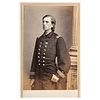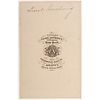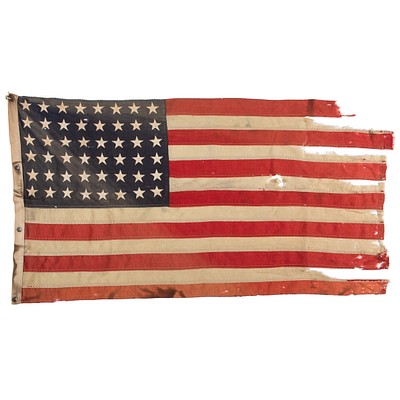CDV of Lieutenant William B. Cushing, USN
About Seller
6270 Este Ave.
Cincinnati , OH 45232
United States
With offices in Cincinnati, Cleveland and Denver, Cowan’s holds over 40 auctions each year, with annual sales exceeding $16M. We reach buyers around the globe, and take pride in our reputation for integrity, customer service and great results. A full-service house, Cowan’s Auctions specializes in Am...Read more
Two ways to bid:
- Leave a max absentee bid and the platform will bid on your behalf up to your maximum bid during the live auction.
- Bid live during the auction and your bids will be submitted real-time to the auctioneer.
Bid Increments
| Price | Bid Increment |
|---|---|
| $0 | $25 |
| $500 | $50 |
| $1,000 | $100 |
| $2,000 | $250 |
| $5,000 | $500 |
| $10,000 | $1,000 |
| $20,000 | $2,500 |
| $50,000 | $5,000 |
| $100,000 | $10,000 |
About Auction
Jun 26, 2020
Cowan's Auctions is delighted to present the June 26 American Historical Ephemera and Photography Auction, including 55 lots devoted to the African American experience, over 175 lots dating from the Civil War Era, and more than 60 lots documenting life in the American West. Cowan's Auctions dawnie@cowans.com
- Lot Description
CDV of Lieutenant William B. Cushing, USN
CDV portrait of "Lieut. Cushing" identified in pencil on verso. E. & H.T. Anthony, after Brady: New York, n.d.
Born in Wisconsin, William Barker Cushing (1842-1874) moved with his family to Chicago, then Gallipolis, OH. Upon the death of his father in 1847, Cushing's mother moved the family to Fredonia, New York, supporting her family by running a school. Young William secured a position as a page in the House in Washington in 1856, and the following year was accepted to the Naval Academy as an acting midshipman (9/25/57). He was not the student his mother surely hoped, and lack of study and aversion to discipline (a harbinger of things to come) resulted in his dismissal from the Academy and resignation from the Navy on March 23, 1861. With war underway Cushing was reinstated as Acting Master's Mate later in 1861. By the following July, serving in the North Atlantic Squadron, Cushing was promoted lieutenant (7/16/62).
Throughout the war, Cushing engaged in daring and dangerous actions characterized by stealthy attacks on Rebel installations with a handful of "volunteers," often under heavy fire. Miraculously he came out of these scuffles as the only one not killed, wounded, or captured. The destruction of the Confederate ironclad ram CSS Albemarle was a typical Cushing operation. On October 27, 1864 Cushing crept up the Roanoke River at night with 21 "volunteers" in a cutter and small steam launch rigged with a spar torpedo and a boat howitzer. He found the Albermarle protected by a log boom connected by chains meant to prevent approach by fire ships and thwart small boats with boarders. Cushing eluded lookouts most of the way upriver, but one alert sentinel on Albermarle spotted the raiders in the dark and sounded the alarm. Coming under a barrage of small arms fire, Cushing managed to ram the Albermarle at full steam, carrying the launch over the slippery logs, pulling the lanyard and exploding the spar torpedo under the Rebel vessel. At the same moment, Cushing and his men were thrown into the water by the concussion, struggling survivors now separated from the group. Cushing swam downstream, attempting unsuccessfully to save one of his crew who was in mid-river, eventually climbing ashore on the other side some distance downstream. He then trudged through swamps until he came upon a Confederate shore post, and, seizing the first opportunity, commandeered their skiff, rowing to the safety of the Federal picket vessel, Valley City. For this daring deed he was immediately promoted to lieutenant commander to date from October 27, 1864. Suffering the ill effects of worsening health, Cushing remained in Navy after the war and advanced to commander (at that time the youngest officer to hold the rank) on January 31, 1872. Another incident occurred just before the end of his life that demonstrated another aspect of Cushing's modus operandi. In 1873, upon learning that the Anglo-American crew of the Virginius, a ship hired by Cuban insurrectionists to land contraband munitions, were being summarily executed at Santiago de Cuba, Commander Cushing took the USS Wyoming, of which he was commander, and without orders steamed for Santiago. He then informed the Spanish governor that if he intended to execute any more of the crew (53 had already been shot), he had better remove all women and children from Santiago first. The executions stopped but not before England and the United States were nearly drawn into a war with Spain. During the summer of 1874 Cushing was sidelined from sea duty and took up the post of executive officer at the Washington Navy Yard, a job that did not mesh with the daring officer's idiom. Meantime, his health deteriorated at a rapid pace and doctors were unable to diagnose the cause of the severe pain in his hip. By Thanksgiving he had become bed ridden and was given doses of morphine to ease the "constant and terrible" pain. On December 8, 1874 he was removed to St. Elizabeth's Hospital and died comatose on December 17 in the presence of his wife and mother. His brilliant career cut short with accolades yet to be realized, William B. Cushing was buried on January 8, 1875 in Bluff Point, the Naval Academy Cemetery at Annapolis.
Provenance: The Richard B. Cohen Civil War CollectionCarte is near EXC. with strong clarity. The double gold row of margin is trimmed away at bottom edge of mount.Condition
- Shipping Info
-
Buyers are required to pay for all packing, shipping and insurance charges. Overseas duty charges are the responsibility of the successful Bidder. Be aware that for larger and/or valuable items, shipping charges can be substantial. - If there is no shipping amount on listed your invoice, you will need to make arrangements to pick up or ship your purchase through an alternative shipping company. Our shipping department can be contacted at 513.871.1670 (ext. 219) or email shipping@cowans.com. - Shipping charges include insurance for your order while in transit. If you have private insurance we will adjust your charge to include only packing and shipping. - Please allow 14 – 21 days after payment to package and ship your purchase as carefully as possible.
-
- Buyer's Premium



 EUR
EUR CAD
CAD AUD
AUD GBP
GBP MXN
MXN HKD
HKD CNY
CNY MYR
MYR SEK
SEK SGD
SGD CHF
CHF THB
THB












